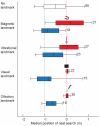Desert ants learn vibration and magnetic landmarks
- PMID: 22412989
- PMCID: PMC3296771
- DOI: 10.1371/journal.pone.0033117
Desert ants learn vibration and magnetic landmarks
Abstract
The desert ants Cataglyphis navigate not only by path integration but also by using visual and olfactory landmarks to pinpoint the nest entrance. Here we show that Cataglyphis noda can additionally use magnetic and vibrational landmarks as nest-defining cues. The magnetic field may typically provide directional rather than positional information, and vibrational signals so far have been shown to be involved in social behavior. Thus it remains questionable if magnetic and vibration landmarks are usually provided by the ants' habitat as nest-defining cues. However, our results point to the flexibility of the ants' navigational system, which even makes use of cues that are probably most often sensed in a different context.
Conflict of interest statement
Figures



References
-
- Wehner R. Desert ant navigation: how miniature brains solve complex tasks. Journal of Comparative Physiology a-Neuroethology Sensory Neural and Behavioral Physiology. 2003;189:579–588. - PubMed
-
- Wehner R. The desert ant's navigational toolkit: procedural rather than positional knowledge. Navigation. 2008;55:101–114.
-
- Wehner R. The architecture of the desert ant's navigational toolkit (Hymenoptera: Formicidae). Myrmecological News. 2009;12:85–96.
-
- Graham P. Insect navigation. In: Breed MD, Moore J, editors. Encyclopedia of Animal Behavior, volume 2. Oxford Academic Press; 2010. pp. 167–175.
-
- Wehner R, Srinivasan MV. Jeffery KJ, editor. Path integration in insects. The neurobiology of spatial behaviour. 2003. pp. 9–30. Oxford University Press, Oxford.
Publication types
MeSH terms
LinkOut - more resources
Full Text Sources
Other Literature Sources

